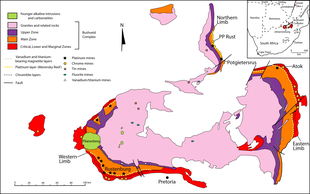The Bushveld Complex is one of the world’s largest and richest layered igneous complexes, located in South Africa. It is renowned for its vast mineral wealth, particularly in platinum group metals (PGMs), chromium, and vanadium. Formed around 2 billion years ago, the Bushveld Complex is a geological marvel that plays a crucial role in the global supply of several key minerals.
Key Features
- Geological Formation: The Bushveld Complex is a large, layered mafic to ultramafic igneous body, covering an area of approximately 66,000 square kilometers. It is divided into four main limbs: the Western Limb, Eastern Limb, Northern Limb, and the less-explored Southern Limb. The complex is known for its layered structure, with different layers rich in various minerals.
- Platinum Group Metals (PGMs): The Bushveld Complex contains the largest known deposits of PGMs, which include platinum, palladium, rhodium, osmium, iridium, and ruthenium. These metals are crucial for various industrial applications, particularly in catalytic converters for automobiles, which reduce harmful emissions.
- Chromium: The Bushveld Complex is one of the world’s leading sources of chromite, the ore from which chromium is extracted. Chromium is essential for the production of stainless steel and various alloys, providing corrosion resistance and enhancing durability.
- Vanadium: The complex is also a major source of vanadium, a metal used to strengthen steel and in emerging technologies such as vanadium redox flow batteries (VRFBs) for large-scale energy storage.
Read more https://en.wikipedia.org/wiki/Bushveld_Igneous_Complex





